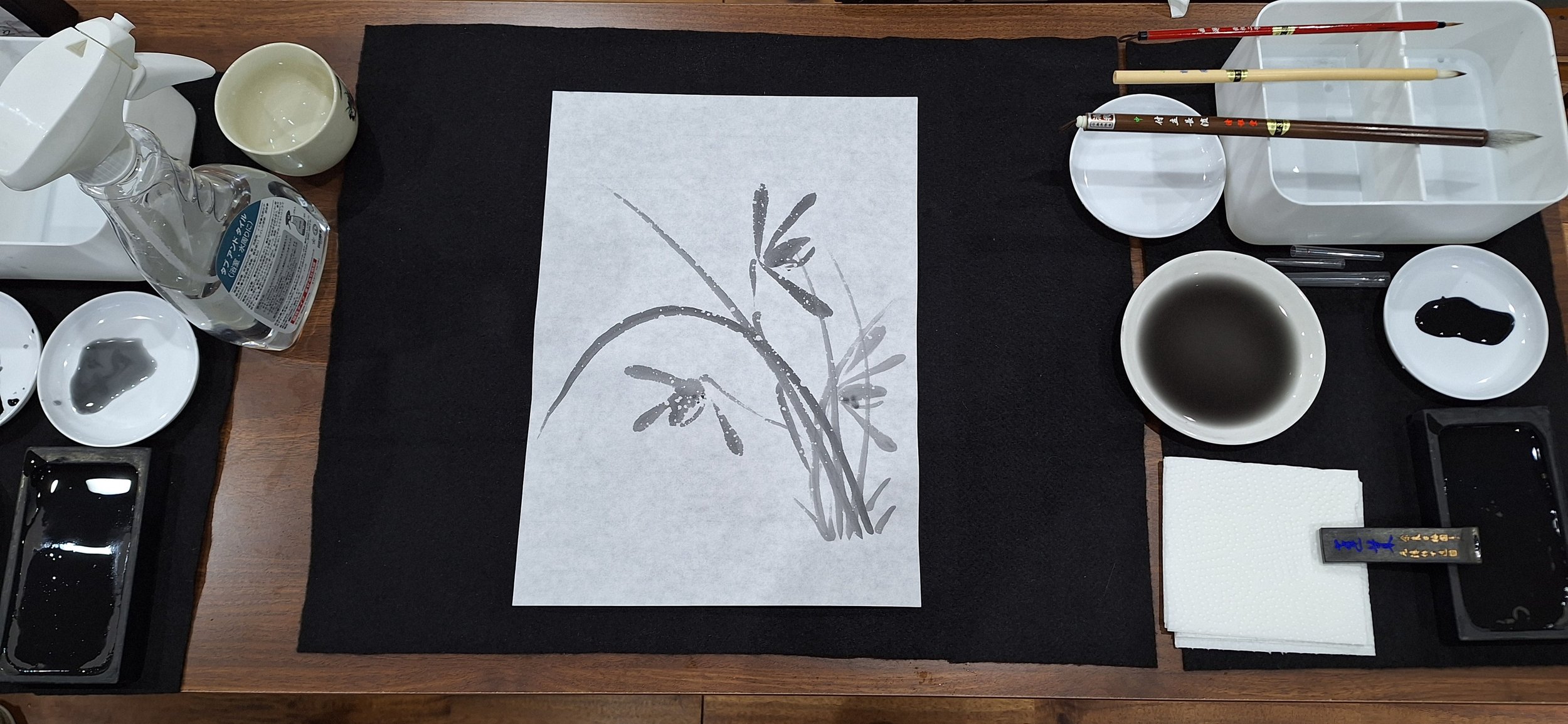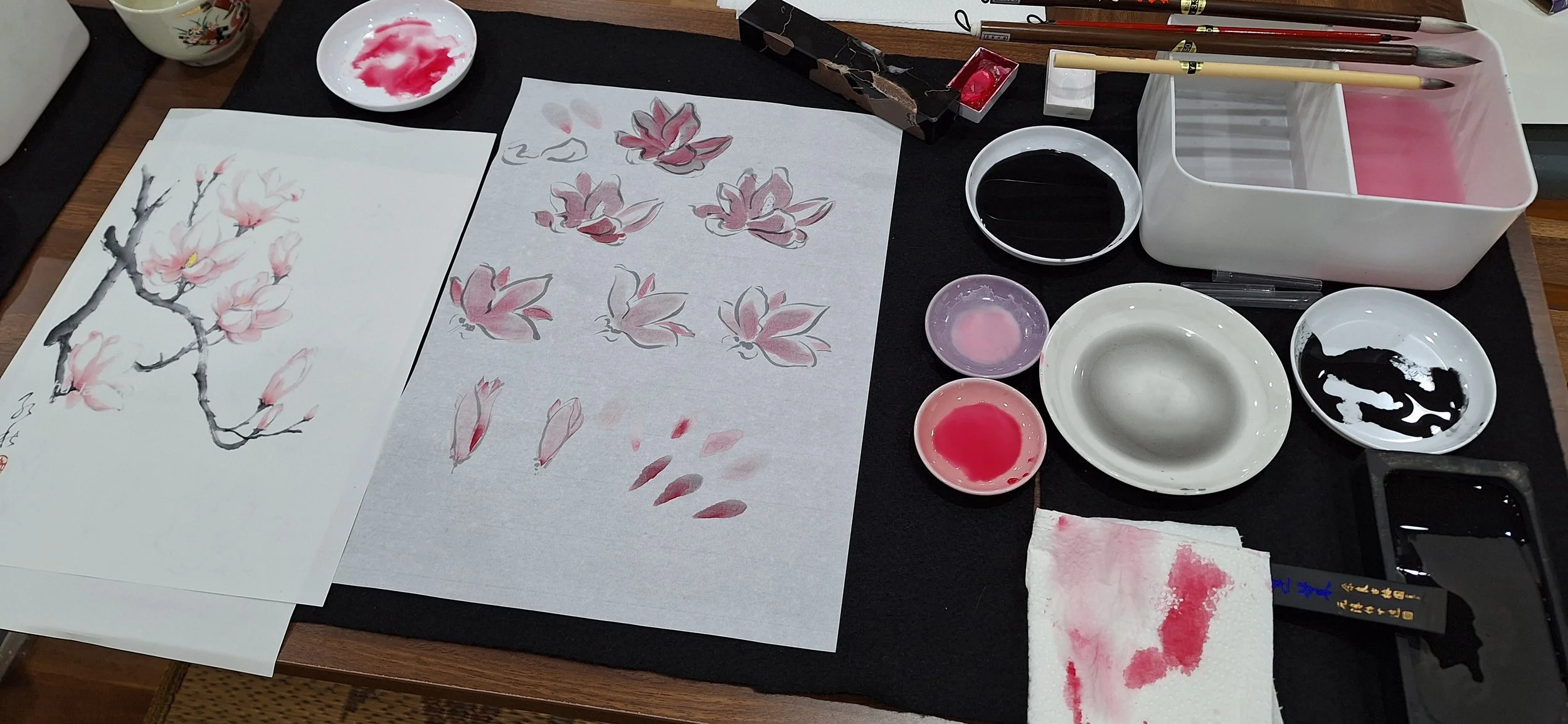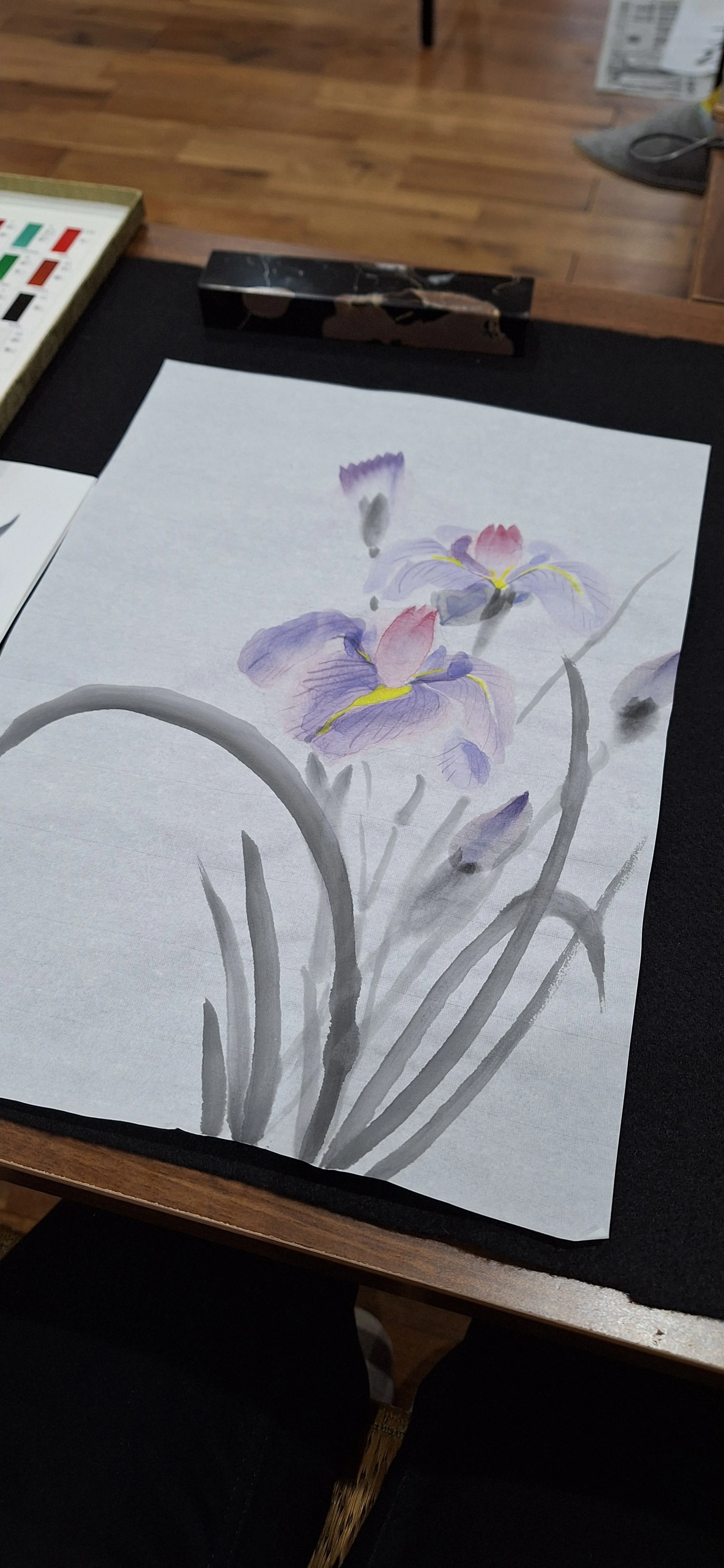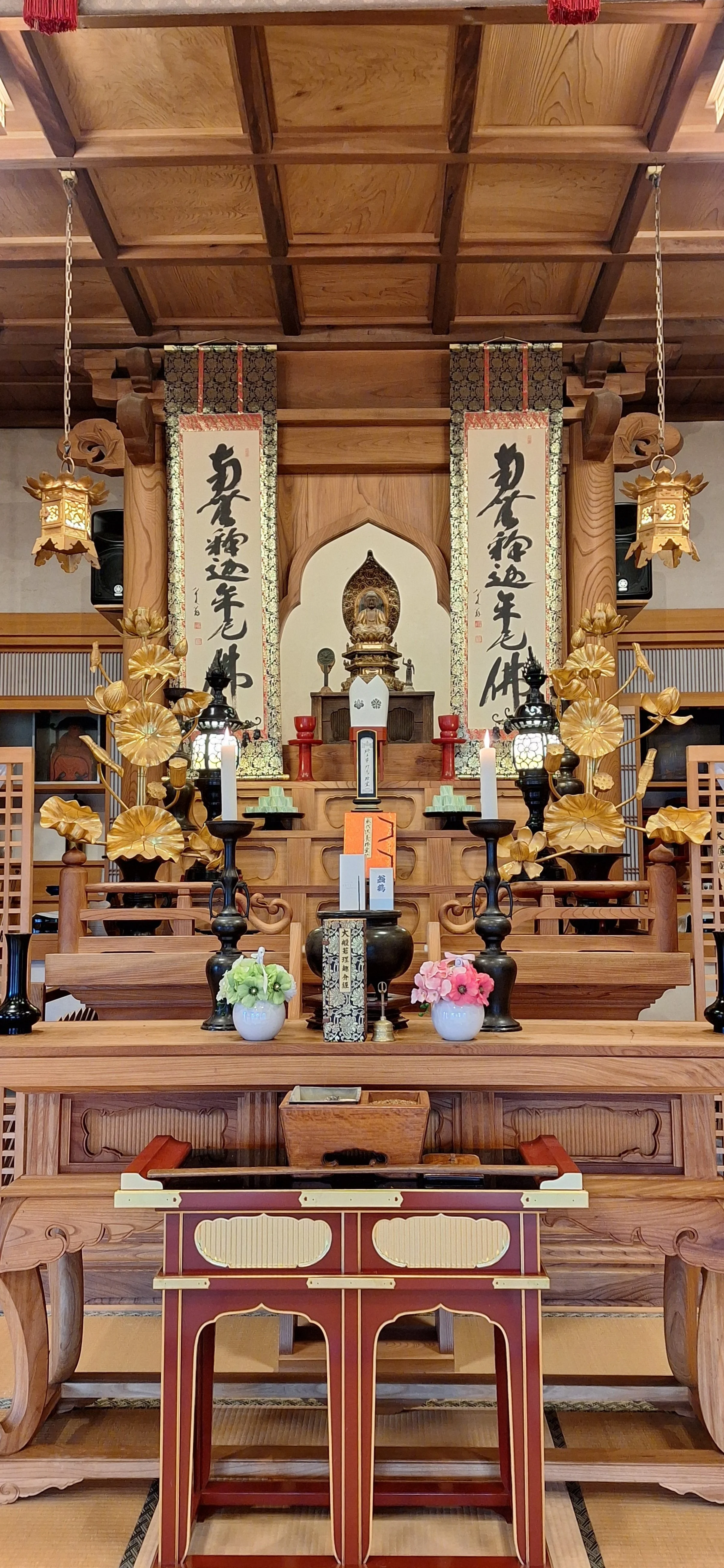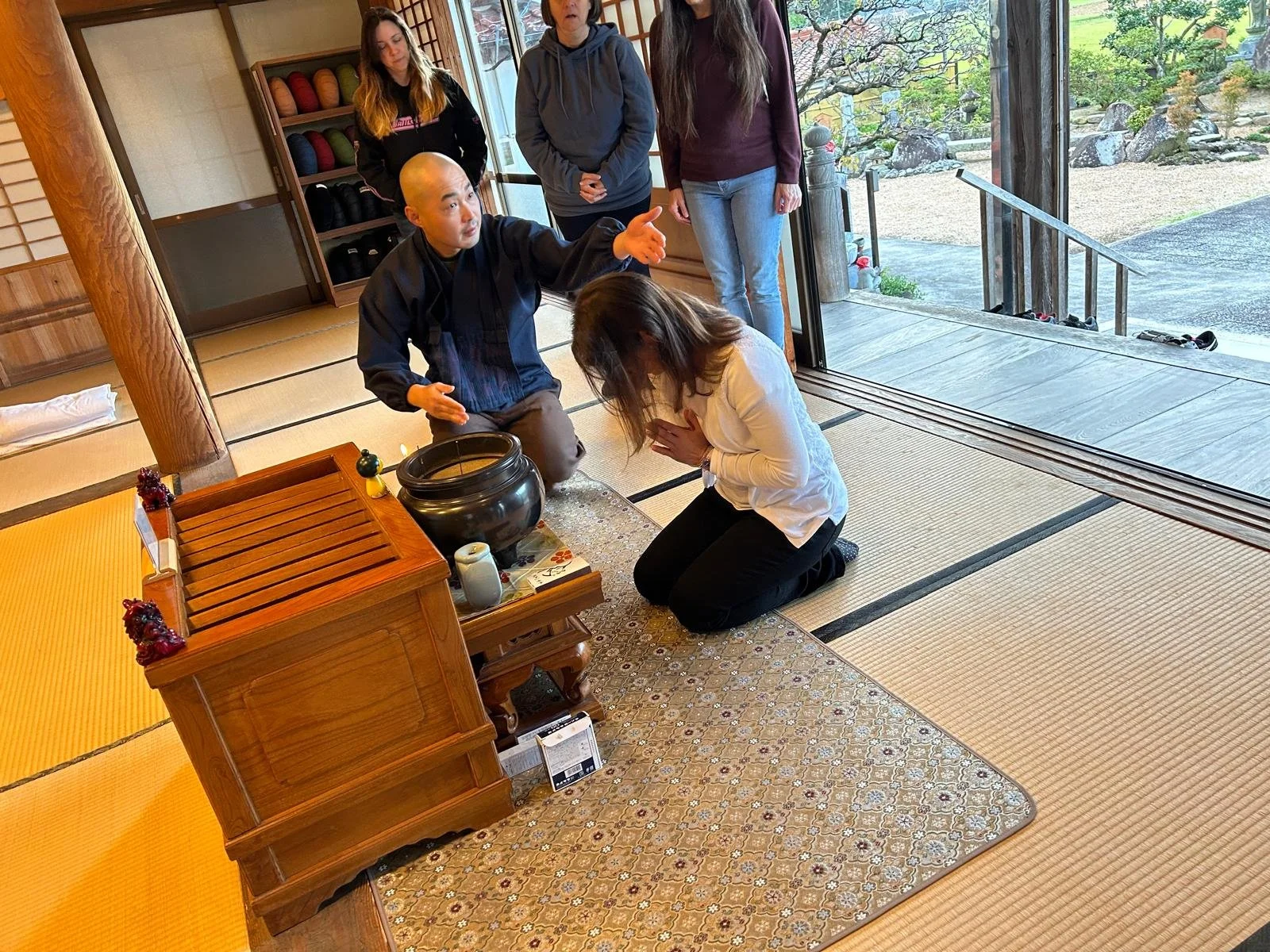Koshu’s Dream House: Chapter 3
All of us were making good progress with our artistic endeavours. So much was covered in such a short space of time...
Throughout our lessons, Akemi introduced us to new sumi-e techniques. Two of those techniques were bokashi and shironuki. Both of these techniques help to create a full moon or setting sun, or capture a moment of falling rain or snow. Such elements added depth and atmosphere to our work.
After practising bamboo in windy conditions, we were shown how to create a rain effect. But before we began, we had to first apply the shironuki technique first. This is where a whitening agent is used, in this case it was wanpau, or “wonder powder”. It was prepared with lukewarm water to create a liquid. This was then painted on to the paper as “rain drops” using sharp, narrow, diagonal brushstrokes. The tricky part is that shironuki is not clearly visible when applied, so you have to be aware of how much, and where you are applying it.
The paper then has to be left to dry. Once dried, any ink wash used will be repelled, so you can have fun conveying bamboo in a rain storm, or an lone orchid slowly being covered by a blanket of snow.
A bokashi ami, (a fine mesh), used in combination with a brush loaded with the liquid whitening agent, can create a snowy effect for the subject.
An orchid painted on paper with the shironuki technique applied using the bokashi ami and brush. Applying the liquid whitening agent directly to select areas also adds to the scene.
The paper is then evenly sprayed with water, gently blotted and a small plate positioned top left. then a brush loaded with ink wash is painted evenly around the plate. This is known as the mizu bokashi technique. It takes an awful lot of practise and patience to achieve the desired effect. The small plate blocks the ink wash. Once removed, you have a wonderful full moon in a Wintery night’s sky. Applying the liquid whitening agent directly onto the orchid in the first stage also adds to the scene, where it creates the appearance that the snow is starting to settle on the petals and leaves.
There were magic moments like that throughout the course. A childlike joy of doing something new and enjoying the results.
Later on, we painted magnolias and irises using colour. I don’t often use colour in my pen and ink drawings, so getting the desired effects from my paints took a little getting used to.
Akemi Lucas printed example on the left, and on the right, open magnolia blooms and bud practise.
This is where again I had to remind myself of the beginner’s mindset, and appreciate the process of learning. Preparing the inks was a relaxing process, but also a chance to laugh with each other. Emily and I would often synchronise our ink stick grinding to avoid table wobbles later on if one of us was mid brushstroke!
Akemi demonstrating ink wash preparation by creating darker and lighter shades of purple.
Iris flowers and buds painted using gansai (traditional Japanese pan watercolour) paints. Despite concerns about how I loaded my brush and pressure control, the colours are more vibrant compared to Western watercolours, and very pleasing to use.
The gansai set I bought from Akemi’s shop. A colour swatch is printed on the inside of the box lid.
During the day, we would focus on sumi-e, but by night, we had our shodo lessons!
Shodo 書道 (the way of writing) is the art of Japanese calligraphy. There are many different styles, and like sumi-e, shodo shares it’s roots in Zen Buddhism. As an artistic form of writing, it is loaded with spiritual meaning.
I was a complete beginner when it came to sumi-e, but I have been practising shodo since Spring 2020. As with anything you take up, it is a never ending journey of learning, improving and progressing, depending on how far you take it. For me on this course, there was a fine line between saying to Akemi that I have a few years of experience, but also being humble about it. As I am self taught, I was grateful to have my bad habits corrected.
We started off with covering the basic brushstrokes, then practised the kanji characters for isshin “one mind”, and ei “eternity”. To learn the balance and composition of the kanji was very important, as well as the individual techniques and brushstroke order.
Eternity 永 and one heart 一心.
It was then time to progress onto choosing how we would like to sign our sumi-e pieces. We all had our special, unique artist’s names.
Akemi individually showed us how to calligraph our names in three different styles, or scripts.
Kaisho - (block / regular) - Clear to read, and used in everyday writing.
Gyosho (semi-cursive) - Requires more movement and flow. Still easy to read, yet elegant.
Sosho - (cursive) - A fluid and expressive style. A continuation of the flow of line from the previous moment. The kanji becomes more abstract in form.
Above are three examples of my artist’s name Phoenix 鳳 hou, calligraphed in each style, Kaisho, Gyosho and Sosho.
“Practise, Practise, Practise”
And practise we did! In the spirit of Akemi’s dedication, a few of us continued practising and reviewing our work late into the night.
Ganjyou-ji, part of the Soto school of Zen Buddhism, Mine-city, Yamaguchi.
In between some of our lessons, Akemi had scheduled a few activities for us. Looking back, we were lucky to have enjoyed some amazing cultural experiences during our stay at Koshu’s Dream House. I would love to cover them all in detail in my blog, but one of the most spiritually enriching and grounding outings was visiting a local temple to practice zazen.
For two days in a row, we rose early to visit Ganjyou-ji, a temple close to Koshu’s Dream House. Akemi had organised for us to meet chief priest Kenji-san.
Built in the Meiji period, Ganjyou-ji Temple's main hall has always offered the community and visitors experiences such as Zen meditation (zazen) and sutra copying (shakyo).
People go to the temple for prayer and blessings.
Sanpo Kojin, the guardian deity of Ganjyou-ji Temple, is the god who protects fire, water and earth. In honour of these Three Treasures of Kojin, various events are held here throughout the year.
As I didn’t quite know what to expect, there was an element of unease, but Kenji-san was so open and kind. He welcomed us and talked us through the rituals upon entering the temple.
We all took turns to place money in the osaisen, to demonstrate our gratitude and reverence. We then rung the singing bowl and lit incense before we entered the temple.
Kenji-san provided a clear and succinct introduction to the practice of zazen.
Kenji-san’s introduction covered stabilising your lower body in a full or half lotus position, breath control, eye, head and hand position. It is a holistic body-mind discipline, where one has to remain still, focus on your breathing and clear your mind.
After initially breathing through our mouths, the zazen session would begin by exhaling for eight second from your nose, then inhaling for four, then repeating that for the length of the session. We started with five minutes, but then increased it to ten, then fifteen. The end of the meditation would involved relaxing and stretching to slowly break zazen posture.
“Do not think about breakfast”
If a breakfast related thought, or any thought for that matter, entered our mind, we just had to let it pass like a cloud. We could listen to the sounds of the temple and take in the scent of the incense, but it was about being physically present and maintaining our fixed posture, not listening to our own internal monologues.
Occasional thoughts did pop into my head, like breakfast (thank you Kenji-san), and then wondering whether or not my nephews would be able to sit still for this long. Think Robert Hay’s scene in Airplane!, where he’s got to concentrate… “echo echo echo…”.
BUT, I did actually manage to achieve moments of time where my mind was completely clear. In this very attention-grabbing, noisy and hectic world, I genuinely felt a moment of inner peace that often feels elusive.
It was very relaxing and restorative.
Kenji-san gifting individually handmade daruma that his partner had made for temple visitors.
For our last zazen meditation with him, Kenji-san gave us a blessing for safe travels and good health (this involved a deeply symbolic Zen Buddhist ritual including a number of performative actions using scripture, chanting and drumming). He also gave us a handmade pouch containing a prayer slip wishing us prosperity and a very cute hand painted daruma. We were all genuinely touched by his cheerful interest and warmth shown towards us.
We were all so thankful and showed our respects with deep bows and enthusiastic waving.
As we left, I looked back over my shoulder and take in the temple one last time. I appreciated my little gifts, including the gift of knowledge that we could practise zazen anytime, anywhere, long after our Japan adventures come to an end.
My little daruma and pouch from Kenji-san
Have you enjoyed my blog so far? If you would like to support me, please consider a donation.
Please visit https://ko-fi.com/phoenixgray to gift as little as £1. You can even leave a message too. All donations go towards the cost of art materials and supporting me as an artist. These blogs are not monetised and all content and art on this site is free to view.
Alternatively, you can promote me for free simply by sharing my blog or website link on your socials. Any online recommendations help me to reach new audiences and in turn get’s me noticed as an artist.
Thank you for your kindness.







